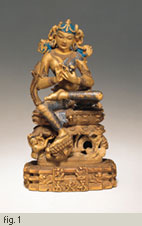
 |
      |
Figure 1, a sculpture of a Buddhist goddess, was acquired by the Asia Society in 1979 and has been described in publications subsequently both as eastern Indian and as Tibetan.1 Finely carved in a beige-colored stone (pyrophyllite),2 the goddess sits upon a lotus, her right leg pendant and the right foot supported by a smaller blossom that emerges from the central lotus stalk. The left leg bends, placing the upturned foot firmly on the right thigh and notably raising the left knee above the lotus support in a posture known as rajalilasana, or “pose of royal ease.” The goddess holds a flower bud while assuming the gesture known as “turning the wheel of the Buddhist law” (dharmachakra pravartana). Two now-broken lotus stalks emerge from the back of the lotus seat, which, when complete, would have blossomed at her shoulders. A precise iconographic identification of the figure is impossible to determine because symbols critical to an exact identification were placed on the now missing lotus blossoms. The most likely identification, however, is that of Mahashri Tara, a popular Buddhist goddess generally associated with compassion, safe travel, and protection from harm and who in this particular form may have been associated with aspirations for wealth.3
The goddess is mounted into a separately carved base consisting of a stepped platform adorned with two crouching lions and five human figures, some representing dancers and musicians. In addition to the significant traces of blue and gold pigment on the goddess's hair, scarf, and skirt, her face is painted gold, and the eyes, brows, and lips are carefully delineated with pigment. Water spirits (nagaraja), one considerably damaged, flank the central lotus stalk and support the lotus seat. The single remaining water spirit also bears pigment. The application of pigment to sculpture is an essential part of Tibetan ritual worship and has on occasion been cited as evidence that a work was made in Tibet. 4 However, the presence of pigment on statues is no longer considered a determining factor in assigning Tibetan origin because Indian sculptures bearing pigment have also emerged in recent years, after centuries of worship in Tibet. Materials sometimes provide clues as to the origins of a work. The Asia Society goddess is one of several dozen small circa eleventh- or twelfth-century Himalayan sculptures that were carved in pyrophyllite and similar finely grained beige stones (e.g., mudstone, kaolinite). 5 It is unclear where the stones were quarried, but some of the carvings have been excavated in India; others were preserved in Tibet, Nepal, and Burma. The original provenance of this group has been the subject of much scholarly debate, with different authors ascribing the same images to eastern India, Tibet, or Burma. Most recently, however, it has become clear that many of these works in mudstone or pyrophyllite were made in Bangladesh or West Bengal, regions of eastern India that supported major international centers of Buddhism during the medieval period. 6 Among them is a mudstone sculpture of the Hindu goddess Durga, now in The Metropolitan Museum of Art (Fig. 4).7 The Hindu iconography is an unlikely subject for Buddhist Tibet or Burma and is itself powerful evidence that the work was made in eastern India, where both Hinduism and Buddhism flourished at this time. The jewelry, lotus petals, and garment design of the Metropolitan carving are very similar to those in the Asia Society goddess (Figs. 1 and 4). The style of the Asia Society carving closely resembles that of other works produced in eastern India during the medieval period. Two circa eleventh- to twelfth- century eastern Indian sculptures (Figs. 5 and 6) exhibit important parallels with the Asia Society figure (Fig. 1). 8 Both depict the goddess Tara seated on a lotus, her right leg pendant, the left foot secured on the right thigh, and the left knee notably raised above the lotus seat, as in the Asia Society example. However closely related in figural type, the Asia Society sculpture is much more finely carved than these two eastern Indian works. In this respect, a more fitting comparison can be found in another beige stone carving of Mahashri Tara (Fig. 7), also from eastern India and currently in the Potala Palace in Lhasa. 9 This eastern Indian work and the Asia Society goddess are similar in many elements of style and in the subtlety of their carving, indicating a common origin in place and time. Tibetan works produced during the eleventh through the thirteenth century often closely followed Indian prototypes, but rarely—during this period—did they match the Indian works in technical skill and artistic subtlety. 10 Although it has also been described as both Tibetan and eastern Indian, a superbly carved beige stone carving of Guhyasamaja Manjuvajra (Fig. 8) in the Cleveland Museum of Art also clearly belongs to the eastern Indian medieval sculptural tradition, and its delicately carved lotus petals closely resemble those in the Asia Society Tara. 11 |
             |